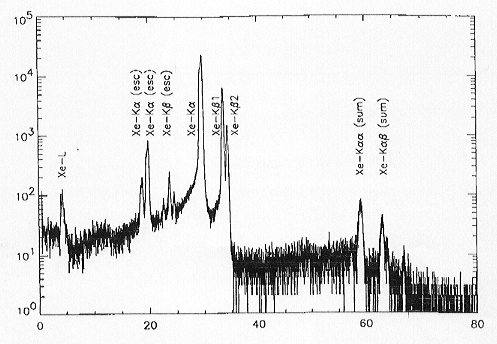

The physics and chemistry of the incorporation of gas bubbles in silicate melts is a subject which is gaining much interest. In glass science, the origin of included bubbles, the physics of their incorporation and the simulation of their transport through the melt has received considerable attention for technical reasons. In the geosciences the transport of volatile phases under pressure is equally important for volcanic processes. In both fields, methods for the determination of chemical partitioning between them and their host glasses are thus important goals.
Here we present the first results of a synchrotron based X-ray micro-beam fluorescence (µ -SYXRF) investigation of the contents of gas and vapour bubbles trapped in glass or melts under conditions of elevated temperatures and pressure. The inclusion-bearing glass samples were analysed in the SYXRF facility at HASYLAB beamline L with white line excitation from a bending magnet source at the storage ring DORID-III. Figure 3.8-6 shows the spectrum of a Xe inclusion 50 microns in diameter with the beam in the central position.
The spectrum shows the intense lines together with the sum and escape
peaks. The perfectly spherical inclusion was automatically scanned in two
dimensions with a synchrotron beam of the same size as the inclusion with
a step size of 15 micron in both directions. The results of such a scan
are illustrated in Fig. 3.8-7 as a three-dimensional perspective.
 |
Fig. 3.8.-6: The XRF spectrum of a Xe inclusion with the beam in the central position. The spectrum shows the intense Xe lines together with the sum and escape peaks. The data were taken with an absorber of 20 mm Al plus 1 mm Cu and a detector collimator of 0.5 mm to prevent system overload. With standard conditions a detection limit of 20 pg/µg within an inclusion of this geometry is achieved. |
In addition to µ-SYXRF, trace element analysis of fluid inclusions have been quantitatively performed with electron microprobe, PIXE, and laser ablation mass spectrometric analysis. The first two methods have to be regarded as destructive for gaseous inclusions. PIXE may be considered non-destructive for some fluid inclusions but for most gas-containing inclusions the heating of the sample destroys the inclusion.
In contrast, the synchrotron based XRF (SYXRF) method is non-destructive
and does not result in significant heating of the sample. Additionally,
the possibility exists of mapping the distribution of solid, liquid, and
gaseous phases in more complex multiphase inclusions in glasses. The synthesis
of such inclusions under well-controlled P-T-X conditions provides additionally
the possibility of developing chemical standards of well-defined composition,
in various matrices.
 |
Fig. 3.8-7: An automatic scan in two dimensions of a spherical Xe-filled inclusion of 50 µm diameter with a synchrotron beam of the same size as the inclusion and using a step size of 15 µm in both directions. The obtained data were deconvoluted with an AXIL program package and corrected for beam intensity and life time. The results are illustrated here as three-dimensional perspective. The dynamic concentration range of more than 3 orders of magnitude confirms the extremely low partitioning of Xe into the glass matrix. |

Tel: +49-(0) 921 55 3700 / 3766, Fax: +49-(0) 921 55 3769, E-mail: bayerisches.geoinstitut(at)uni-bayreuth.de
 Previous page
Previous page